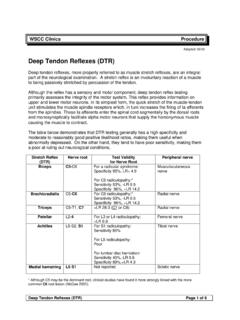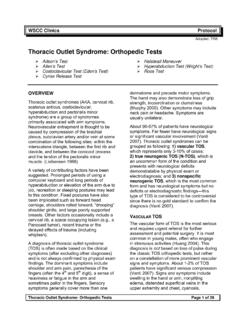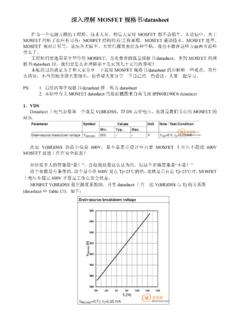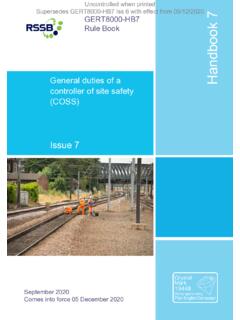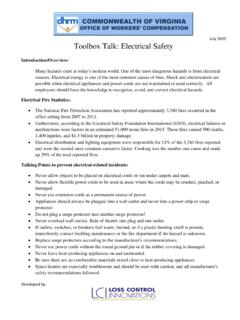Transcription of Questionnaire: How to Score the DASH - Wing FTP Server
1 WSCC Clinics Protocol Adopted: 5/99. Questionnaire: How to Score the DASH. The DASH (Disabilities of the Arm, That way, specific impairments or aggra- Shoulder, and Hand) questionnaire has vations can be identified that may sug- been developed to measure disability and gest a need for further therapeutic inter- symptoms related to upper extremity ventions. musculoskeletal disorders, thus eliminat- ing the need for separate questionnaires The DASH is completed by the patient, for the shoulder, wrist, or elbow. minimizing observer bias in outcome as- The 30-item questionnaire includes 21 sessment. It also allows for follow-up by physical function items, 6 symptom items, mail for those who, for one reason or an- and 3 social/role function items. There other, do not return for treatment. are also two optional 4-item modules: one intended for athletes and musicians, The DASH Questionnaire and the other for working populations.
2 The DASH has four sections: A-D. Parts The DASH can be given at regular inter- A and B are required; Parts C and D are vals at the clinician's discretion ( , optional. Parts A and B considered the weekly), or during the initial patient work Function/Symptom portion of the test . up and then repeated at times of formal comprise 30 items that are marked from 1. re-evaluation. It is a quantifiable method (No Difficulty) to 5 (Unable). of tracking improvement or establishing maximum therapeutic effect. And to as- Optional components C and D, involve sess changes in the most problematic ac- questions about Sports/Performing Arts tivities, practitioners can simply eyeball and Work and contain four questions changes in a specific area or areas of the each. test. The following is a sample from Part A of the DASH Questionnaire: No Mild Moderate Severe Unable Difficulty Difficulty Difficulty Difficulty 1.
3 Open a new or tight jar 1 2 3 4 5. 2. Write 1 2 3 4 5. 3. Turn a key 1 2 3 4 5. 4. Prepare a meal 1 2 3 4 5. PAGE 1 OF 3 QUESTIONNAIRE: HOW TO Score THE DASH. Scoring Parts A and B 135 30. (Function/Symptoms Section) = In brief . Use a calculator A Score of would indicate a high de- Add up the points marked by the patient gree of disability. Subtract 30. Divide by Please note: Because the DASH is a The answer is the DASH Score . relatively new test, a fixed scale indicating precise levels of disability corresponding The response to the first 30 items of the to the numbers remains to be estab- DASH are added to form the raw, or ac- lished. Studies to evaluate reliability, va- tual, Score . For example, if a patient an- lidity, and sensitivity to clinical change are swered 2, or Mild Difficulty, to all 30 ques- currently being conducted.
4 Tions, the raw Score would be 60. A mini- mum Score is 30; a maximum is 150. The Scoring Optional Modules: Parts range of the scores, therefore from 30. to 150 equals 120. C and D (Sports/Music or Work). The raw Score is then transformed to a In brief . zero-to-100 scale with zero reflecting no Use a calculator Add up the points marked by the patient disability (good function) and 100 reflect- Subtract 4. ing maximum disability. Divide by The answer is the DASH Score . To transform the Score to the zero-to-100. scale, you subtract the minimum possible Optional Parts C and D of the DASH each Score , or 30, from the raw Score and di- have four items. The goal of these sec- vide by , which is the possible Score tions is to include items in the DASH that range (120) divided by 100. capture the special difficulties not en- countered in daily living by professional Raw Score 30 (minimum Score ) musicians, athletes, or those in certain occupations with upper extremity condi- (range of scores 100) tions or injuries.
5 Sample Score The maximum Score of this section is 20. with a minimum of 4. The range of scores Assume that a patient answered 15 of the is therefore 16. This Score is also trans- 30 questions in Parts A and B with a 4, formed to a zero-to-100 scale with lower indicating Severe Difficulty. For the scores reflecting minimal disability, and other 15 questions, the patient indicated a higher scores reflecting more disability. 5, or Unable. To get the Raw Score , 15 To transform the Score to the zero-to-100. X 4 would be added to 15 X 5. Therefore, scale, you subtract minimum possible 60 would be added to 75 for a Raw Score Score , or 4, from the raw Score and divide of 135. Here is how a Raw Score of 135 by , which is the possible Score range would be transformed to the zero-to-100 (16) divided by 100. scale. QUESTIONNAIRE: HOW TO Score THE DASH PAGE 2 OF 3.
6 Raw Score 4 (minimum Score ). (range of scores 100). Missing Items If less than 10% of items from Parts A. and B (3 items or fewer) are left blank by the respondent, the mean average of the scores of the other items may be substi- tuted. For example, if a person responds with 28 3's and two blanks, the missing values can be replaced by a value of 3.. If more than 10% are left blank, you will not be able to calculate a DASH Score . However, no questions can be skipped in the high performance Sports/ Music or Work modules because they have only 4. items each. Copyright 1999 Western States Chiroprac- tic College Primary Author - Owen T. Lynch, DC. Reviewed by CSPE Committee - Laura Baffes, DC. - Owen Conway, DC. - Daniel DeLapp, DC, DABCO, LAc, ND. - Kathleen Galligan, DC, DABCI. - Lorraine Ginter, DC. - Ronald LeFebvre, DC. - Owen T. Lynch, DC.
7 - Steve Oliver, DC. - Karen E. Petzing, DC. - Ravid Raphael, DC, DABCO. - Anita Roberts, DC. References Adapted from Scoring the DASH from The Insti- tute of Work & Health and the AAOS/COMSS/. COSS Outcomes Data Collection Instruments, Toronto, Ontario, Canada. PAGE 3 OF 3 QUESTIONNAIRE: HOW TO Score THE DASH.

